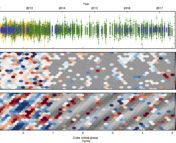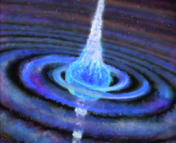Authors: Sengar, R., Balakrishnan, V., Stevenson, S. et al.
First Author’s Institution: Swinburne University of Technology, Australia
Status: arxiv [open access]
Everyone needs close friends – even neutron stars! There are 16 known binary systems in our Galaxy, where both components are neutron stars. These systems – known as double neutron stars (DNS, not to be confused with the internet protocol of the same name) – are excellent probes of general relativity. These systems radiate gravitational waves, causing their orbit to shrink, which eventually (in ~ a billion years!) leads to them merging. Today’s paper describes a new DNS discovered in the Milky Way that has several peculiar properties, which shed light on how it may have formed.
DNS systems – how are they formed?
A DNS starts off as a normal binary – consisting of two regular, massive (> 10 Msun) stars on the main sequence. Eventually (in a few million years) the more massive star evolves off the main-sequence, becomes a giant, explodes as a core-collapse supernova and thus – the first neutron star is born. This neutron star has a large magnetic field and emits a beam of radio waves through a process known as cyclotron emission. If this beam points towards us, we see periodic radio pulses from the neutron star, once per rotation period. Such a neutron star is termed as a pulsar.
Now the fun begins. When the second star evolves to become a giant, it starts transferring its outer layers onto its companion neutron star. This “mass transfer” is aided by the steep gravitational potential of the neutron star. As large amounts of angular momentum is transferred from the giant onto the neutron star, the neutron star is spun up to extremely fast speeds – with spin periods of a few milliseconds! These fast spinning neutron stars are called millisecond pulsars. The giant star eventually explodes to form its own neutron star – thus forming the DNS system. However, the presence of the millisecond pulsar affects the evolution of the giant star, and when it explodes it results in an unusual supernova called an “ultrastripped” supernova (as the outer layers of the star have been stripped by the companion). Despite the several thousand supernovae known to date, only a couple of ultrastripped supernovae have been identified.
Finding DNS – Timing is the key :
The first step in searching for DNS is to identify the millisecond pulsar. If the millisecond pulsar was not in a binary, we expect to see regular radio pulses from it separated by precisely the spin period. However, if the neutron star was orbiting a binary companion, the arrival times of its radio pulses would change slightly because of its Keplerian orbital motion. Additionally, if the companion was an extremely dense object like a neutron star, there will be additional specific changes in the arrival times due to general relativity (GR). Thus, to identify whether the millisecond pulsar is in a binary system, we need to observe a large number of pulses from it and measure their arrival times extremely precisely. This technique is known as “pulsar timing”.
How many pulse times do we need to measure? It turns out that the Keplerian, non-relativistic effects of a binary companion can be measured using a few hours of radio observations. However, measuring precise GR effects can require several months or years of pulsar timing, as GR effects can be fairly small. This problem is extremely computationally challenging.
The HTRUS survey :
Today’s paper deals with data from the High Time Resolution Universe South survey – a dedicated survey to search for double neutron stars using the Parkes Radio Telescope in Australia. This survey observed the southern Galactic plane at 1325 MHz frequency to search for new pulsars. For every pulsar they detect in their survey, they fit the pulse arrival times with a Keplerian model to see if the pulsar is in a binary system. Using these methods, they identified a new millisecond pulsar PSRJ1325-6253 – the object of today’s discussion. Their search pipeline flagged this pulsar as having a possible binary companion. The authors then initiated a year-long dedicated observational campaign with the Parkes radio telescope to precisely measure the pulse arrival times and check for general relativistic effects. They fit their long-baseline observations using a general relativistic model and derived several orbital parameters of the system. In particular, they find that the system has a total mass of ~2.6 Msun, orbital period (P) of ~1.8 days and an orbital eccentricity (e) of ~0.064.
Too round to be true?
PSRJ1325-6253 has a period of 1.8 days – amongst the largest periods found in DNS systems. Long period (>1 day) DNS systems usually have large eccentricities. However, PSRJ1325-6235 has an extremely low eccentricity, i.e. its orbit is almost circular. The authors use this unique configuration to speculate about the formation mechanism of the PSRJ1325-6235. First, they note that because the period is large, the orbital separation is also wide (compared to other known DNS systems). They estimate that the orbit of such a wide system cannot be substantially altered by GW radiation since formation. Thus, the current state of the DNS system is almost exactly as it was immediately after the second supernova explosion (described above).
Prior to the second supernova explosion, we have a neutron star accreting material from a giant companion. We expect the orbit to be circular due to tidal interactions between the neutron star and the giant. When the giant star explodes, it can impart a velocity kick to the newly formed neutron star. If the velocity kick is high enough, the orbit can be de-circularized, producing a high eccentricity orbit. The low orbital eccentricity of PSRJ1325-6235 suggests that the kick imparted in the supernova explosion was extremely small. Small kicks are consistent with a particular kind of supernova known as an electron-capture ultrastripped supernova. In this supernova, the degenerate core of the stripped star captures an electron which triggers several runaway thermonuclear reactions. The mass of the core increases as heavier elements are formed in these reactions, eventually causing it to collapse gravitationally. The accompanying explosion is expected to be symmetric and ejects very small amounts of mass, imparting a very low kick velocity to the remnant neutron star. The authors claim that the wide orbit and low eccentricity of PSRJ1325-6235 suggest that it originated in the extreme case of an ultrastripped supernova.
The authors note that future observations will help study this system in more detail. For example, from their current observations, the authors were able to constrain the total mass of the system, but not the individual masses of the two neutron stars. Additional timing observations will help break the degeneracy and determine individual masses of the system and confirm its formation mechanism. Finally, identifying additional DNS will help study the properties of their population and place PSRJ1325-6253 in a broader context.
Edited by : Katy Proctor
Featured Image Credit: NASA/Dana Berry, Sky Works Digital




